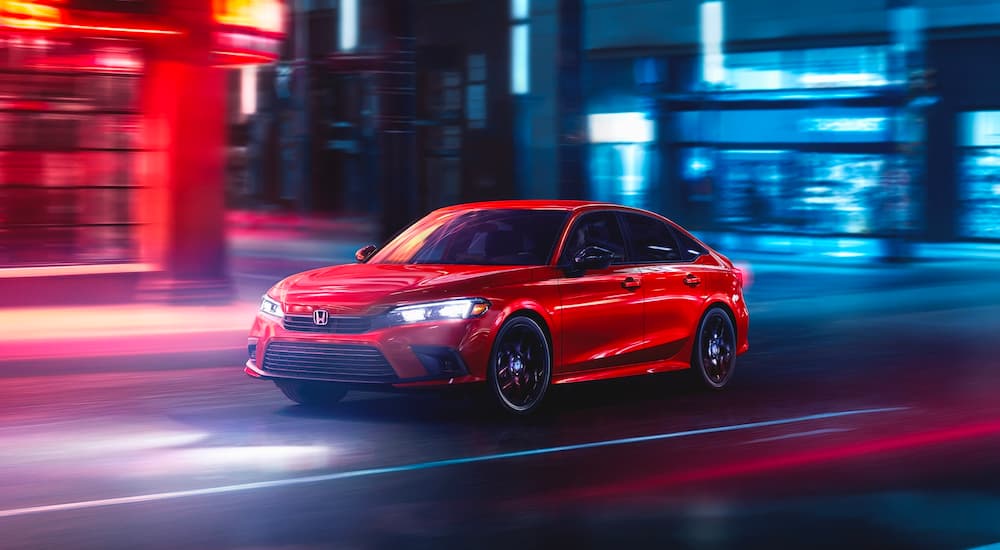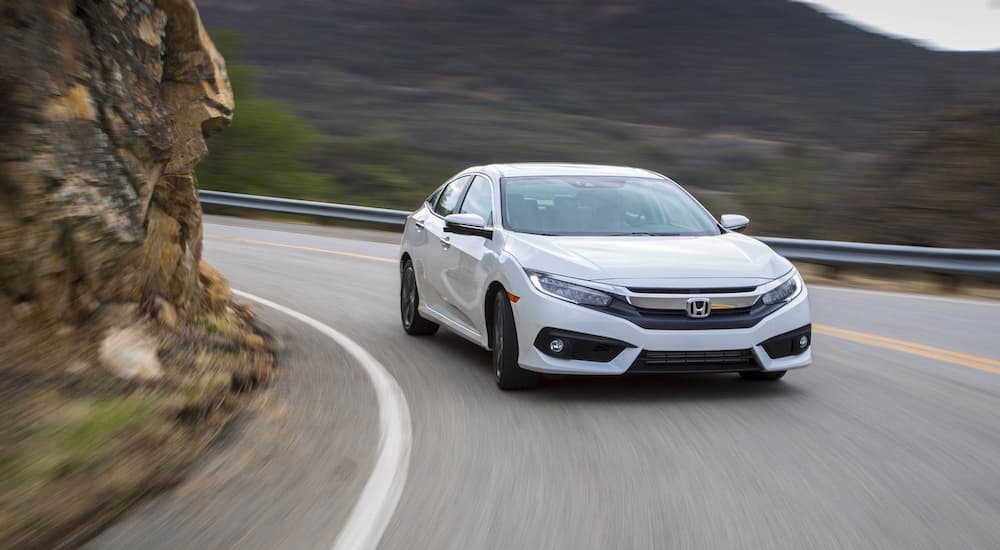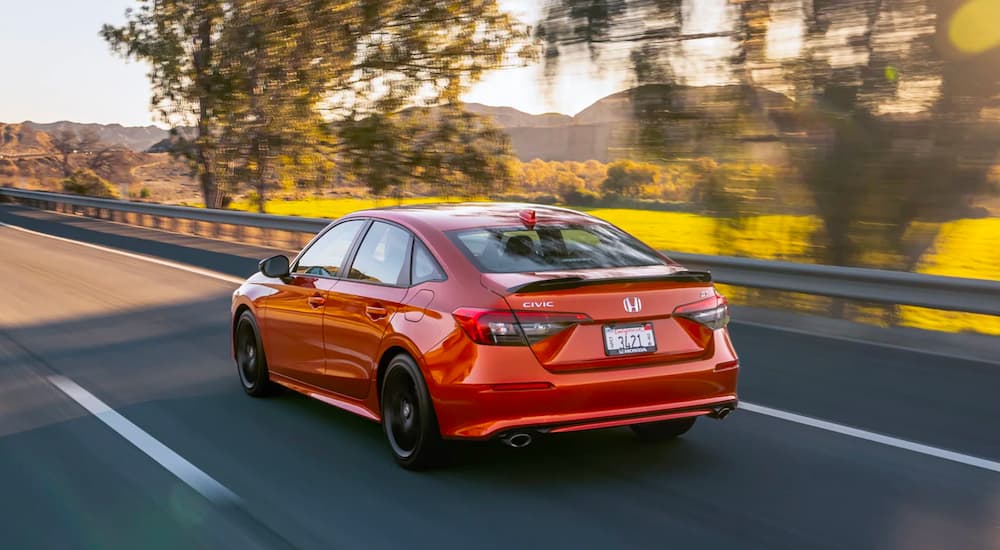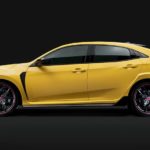Considering the auto industry, in general, is only about 100 years old, give or take a decade or so, it’s impressive for any particular car company to have been around for most of that. Even more impressive, however, is when one model has been available for half that, only a handful of vehicles on the road today can trace their lineage back that far. And yet, if you head to a Honda dealer near you, that’s exactly what you’ll find: the Honda Civic has been hitting the road here in the US for 50 years and shows no signs of stopping.
These days, the Civic is the second-most-popular car in the US, just behind the Toyota Camry, though, in fairness, the Camry has been a huge favorite for more than 40 years now. Although it started as a subcompact coupe, the modern Civic is a compact sedan that’s perfect for a wide range of drivers, which explains why it has remained so popular. In fact, more than 27 million Civic models have sold worldwide since it was first introduced (more than 12 million here in the US), making it one of the best-selling cars of all time. For its 50th anniversary, let’s take a look at where it’s been over the years across eleven generations of reliable and sporty performance.
First Generation (1973-1980)
The Civic launched in Japan in 1972, which is why Honda celebrated its 50th-anniversary last year, but we didn’t get it here in the US until the following year. The first-generation Honda Civic was available in a number of configurations: a two-door or four-door fastback sedan or a three-door or five-door hatchback. It featured a 1.1L four-cylinder water-cooled engine, with vinyl bucket seats and luxury options like simulated wood trim and air conditioning. The incredibly fuel-efficient engine was perfect for the oil crisis and rising gas costs in the US, making it a very attractive car.
Second Generation (1981-1983)
While the first generation of the Civic spanned most of the 1970s, the second generation only lasted a few years. Launched for the 1981 model year, it featured a 1.3L engine, with a 1.5L option available for boosted power, along with two manual transmission options and even a semi-automatic or “Hondamatic” two-speed transmission. This model leaned into its sedan design with a four-door model available, along with both hatchback and wagon options.
Third Generation (1984-1987)
Just a few years after the second generation, the third-generation Honda Civic launched for the 1984 model year with a full redesign that gave it a cleaner overall look. The separate hatchback and wagon models from the previous years were combined into a single “shuttle wagon” model, streamlining the options for this generation. It featured a new 1.5L four-cylinder engine; an all-new Si model was introduced with a more powerful engine and boosted performance. In 1984, a four-wheel drive Civic also became available for the first time.
Fourth Generation (1988-1991)
For the 1988 model year, Honda released a redesigned Civic that was larger in size, beginning the move from its subcompact origins toward the compact model we know today. This generation marked the introduction of a fully independent rear suspension on all Civic models, along with sedan and hatchbacks remaining available options. It closed out the 1980s in style and paved the way for the next decade.
Fifth Generation (1992-1995)
Released in late 1991 for the 1992 model year, the Civic was once again redesigned for its fifth generation, growing slightly larger while also becoming sleeker and more aerodynamic. The standard Civic was incredibly fuel efficient, making it an attractive prospect for many drivers, while the Civic Si featured a sporty engine for boosted performance. Even decades later, this generation remains quite popular among a certain segment of enthusiasts and racers looking for a vehicle they can mod aggressively.
Sixth Generation (1996-2000)
While three generations of Civics spanned across the 1980s, the ‘90s were simpler, and the sixth generation closed out the decade. Released for the 1996 model year, this version of the Civic was once again updated and redesigned, growing closer aesthetically to the sedans we see today. For the sixth generation, the standard model came with a 1.6L four-cylinder engine, while higher-tuned versions of this engine were offered on other trims. There was also a Civic Si Coupe available for the last two years of this generation.
Seventh Generation (2001-2005)
Honda launched into the new millennium with the seventh-generation Civic, released in September of 2000 for the following model year. From the outside, this version of the Civic was much the same size, but a redesign with a flat rear floor allowed for greater interior space and officially moved the Civic into the compact car category. This generation saw the introduction of a new engine, along with the shift from a front double wishbone suspension to a MacPherson strut to create more room for it to fit into. The Civic Hybrid was also introduced during this generation.
Eighth Generation (2006-2011)
Launched for the 2006 model year, the eighth-generation Honda Civic would run throughout the rest of the “aughts” and introduced a number of new options. In terms of worldwide development, Honda developed two platforms for the Civic: one for the sedan and coupe and another for hatchback models designed for Europe. Here in the US, we got a sportier version of the Civic Si developed by Mugen Motorsports called the Civic Mugen Si Sedan for the 2008 model year with a performance exhaust system, sport suspension, and exclusive body details.
Ninth Generation (2012-2015)
For the 2012 model year, Honda released its ninth-generation Civic with both a sedan and coupe available here in the US. Despite its redesign for the new generation, there was a fair amount of criticism of the 2012 Civic, and it wasn’t a favorite among many reviewers. In response to this, Honda made significant changes to the Civic, including a full facelift and refresh for the 2013 model year, demonstrating a willingness to listen to feedback and make changes that we don’t see very often in the auto industry.
Tenth Generation (2016-2021)
As Honda developed its next-generation Civic, it abandoned its previous method of utilizing different platforms for different markets and instead created a single, unified platform used to make all Civic models offered worldwide. The newly unified Civic was released in three body styles for its tenth generation: a four-door sedan, a two-door coupe, and a hatchback, all with similar designs and performance. For this generation, the sporty Civic Si model remained a popular option, though it was somewhat overshadowed by a high-performance Civic Type R, which was released officially in the US for the first time.
Eleventh Generation (2022-Now)
To mark the 50th anniversary of its initial Japanese release, Honda delivered an all-new eleventh generation of the Civic for 2022. This generation marked the end of the coupe body style, as it has diminished in popularity recently, though sedan and hatchback models remain popular among drivers. The sporty Si trim has remained available, and while a high-performance Type R was not ready for its first year, the 2023 Civic Type R is the fastest Civic ever built, thanks to its aerodynamic design and 315-hp turbocharged engine.
Here’s to Fifty More Years
As you can see, the Honda Civic has been through many changes and has come a long way since it was first released in the US 50 years ago, but it remains a popular and sporty option in a wide range of styles. With so many changes hitting the auto industry recently (and more expected in the years to come), it will be interesting to see what the future holds for the Civic. Since it’s Honda’s best-selling car, there’s no doubt it will remain a vital part of their lineup no matter what else happens. In other words, I have no doubt that the twentieth-generation Civic that our kids will be driving will be a very interesting piece of machinery.






